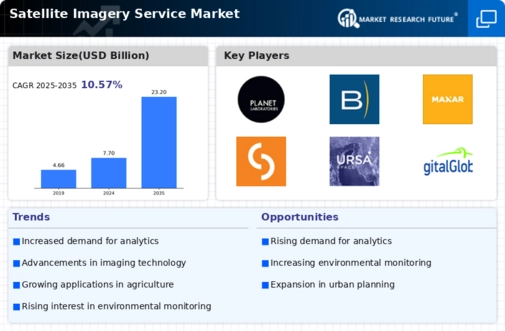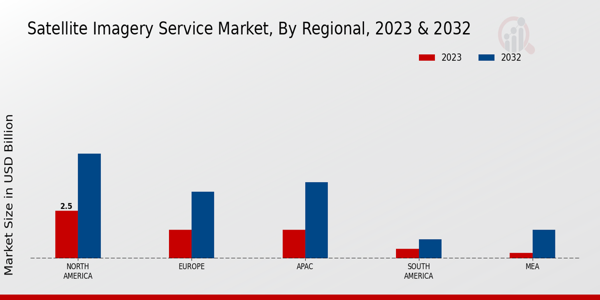Market Growth Projections
The Global Satellite Imagery Service Market Industry is projected to experience robust growth over the coming years. With an estimated market value of 7.7 USD Billion in 2024, the industry is expected to expand significantly, reaching 23.2 USD Billion by 2035. This growth trajectory indicates a compound annual growth rate of 10.54% from 2025 to 2035, reflecting the increasing reliance on satellite imagery across various sectors. The demand for high-resolution imagery and advanced analytics is likely to drive this expansion, as organizations seek to leverage satellite data for strategic decision-making and operational efficiency.
Government Initiatives and Funding
Government initiatives and funding play a pivotal role in shaping the Global Satellite Imagery Service Market Industry. Various nations are investing in satellite technology to bolster national security, environmental monitoring, and disaster response capabilities. For example, the United States government has allocated substantial budgets for satellite programs that enhance surveillance and data collection. Such investments not only stimulate market growth but also encourage public-private partnerships, fostering innovation in satellite services. The anticipated compound annual growth rate of 10.54% from 2025 to 2035 reflects the increasing recognition of satellite imagery's value in addressing global challenges.
Emerging Markets and Global Expansion
Emerging markets are becoming increasingly significant in the Global Satellite Imagery Service Market Industry. Countries in Asia, Africa, and Latin America are investing in satellite technology to enhance infrastructure development, agriculture, and disaster management. This expansion is driven by the need for accurate data to support rapid urbanization and economic growth. As these regions adopt satellite imagery solutions, the market is poised for substantial growth, contributing to the overall projected increase in market value. The integration of satellite services into various sectors in emerging economies highlights the global relevance of satellite imagery in addressing diverse challenges.
Increasing Demand for Geospatial Data
The Global Satellite Imagery Service Market Industry experiences a surge in demand for geospatial data across various sectors, including agriculture, urban planning, and environmental monitoring. As organizations increasingly rely on precise location-based data for decision-making, the market is projected to reach 7.7 USD Billion in 2024. This growth is driven by the need for accurate mapping and analysis, which supports sustainable development initiatives and enhances resource management. For instance, agricultural firms utilize satellite imagery to optimize crop yields and monitor land use, demonstrating the practical applications of geospatial data in real-world scenarios.
Technological Advancements in Satellite Systems
Technological innovations in satellite systems significantly propel the Global Satellite Imagery Service Market Industry. The development of high-resolution imaging and advanced sensors enhances the quality and accuracy of satellite data. These advancements enable applications in disaster management, climate change monitoring, and urban development. As a result, the market is expected to grow substantially, with projections indicating a value of 23.2 USD Billion by 2035. Enhanced imaging capabilities allow for real-time data collection, which is crucial for timely responses to natural disasters and urban planning challenges, thereby increasing the overall utility of satellite imagery.
Growing Applications in Environmental Monitoring
The Global Satellite Imagery Service Market Industry benefits from the growing applications in environmental monitoring. As climate change concerns escalate, satellite imagery becomes indispensable for tracking environmental changes, deforestation, and urban sprawl. Organizations utilize satellite data to assess the impact of human activities on ecosystems and to develop strategies for conservation. This trend is likely to drive market growth, as stakeholders seek reliable data to inform policy decisions. The increasing emphasis on sustainability and environmental protection underscores the importance of satellite imagery in fostering informed decision-making and promoting ecological balance.










